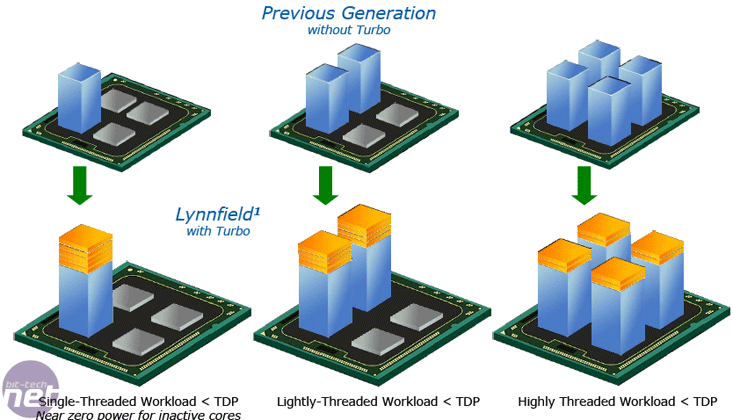
Turbo Boost
Turbo Boost was a feature we generally disregarded and disabled on LGA1366 Core i7 CPUs, because the single jump in multiplier didn't give enough extra performance and it hindered overclocking. Some motherboards were clever enough to force the extra multiplier on permanently, allowing for more overclocking headroom, but the bottom line was that while a nice idea, Turbo Boost wasn't worth worrying about.Lynnfield, however, is different.
With an improved PCU (power control unit) that allows a finer measurement of current drawn across the chip, the Turbo Boost on Lynnfield can increase the multiplier by four or five steps - up to 665MHz. This maximum is usually only applied in single- or dual-threaded applications (which is most of them) and can mean that a lowly Core i5-750 can outpace a mighty Core i7-920 in some situations. See our Intel Core i5 and Core i7 review for more performance analysis. Intel hasn't given the new version of Turbo Boost a new name, so we're going to call it Turbo Boost (rev 2).

We can see Turbo Boost (rev 2) negating the point of overclocking for many, as it gives you a CPU that can operate with all the power saving efficiency of Speed Step (dropping the CPU by six multipliers or so) plus all the extra performance of Turbo Boost (rev 2) boosting the multiplier by up to five steps. You can see the advantages of Turbo Boost (rev 2) in our Lynnfield review[/eurl and also the advantages of overclocking your CPU beyond what Turbo Boost (rev 2) is capable of.
On top of excellent overclockability, some P55 motherboards support BIOS profile switching, so the motherboards can be overclocked on the fly to provide additional performance when needed (gaming or encoding), but then set back to stock (or sub-stock) speeds when you're doing less work - web browsing, watching movies or playing music for example.
DDR3 Memory
As we've previously mentioned, the memory controller of Lynnfield is a dual-channel unit, rather than the triple-channel controller of LGA1366 Core i7 CPUs. Both memory controllers can only talk to DDR3 memory, unlike AMD's DDR2/DDR3 memory controller in its Phenom II CPUs. Lynnfield's memory controller has a default maximum frequency of 1,333MHz rather than default maximum of 1,066MHz of LGA1366 Core i7. Lynnfield's memory controller is also very overclockable, and we've hit memory speeds of 2,300MHz with the right DIMMs and motherboard.As a dual-channel controller, Lynnfield is at a disadvantage to LGA1366 CPUs when it comes to memory capacity. For those wanting more than 8GB of memory, 8GB (4GBx2) kits will also be available in Q4 this year so you will be able to stuff 16GB of memory into a LGA1156 motherboard. However, these DIMMs will naturally command a premium price and likely "limited" overclocking headroom at first. And if huge amounts of memory is your thing, why not opt for LGA1366 and its six memory sockets? You can have 12GB of memory in a system right now.
Lynnfield still has the large L3 cache (with Smart Cache and aggresive prefetchers of LGA1366 CPUs to compensate for the diminished bandwidth, but the memory controller in the LGA1366 CPUs is still superior.
When it comes to overclocking, there's a potential limitation, as the Uncore voltage cannot be changed. The Uncore area contains the L3 cache, memory controller and PCI Express controller. We're unsure whether all of the Uncore is on the same voltage plane at the moment, and we're also unsure as to why if a voltage is applied to the memory, the ability to change that voltage isn't given in any motherboard we've tested so far.

It's not all bad though because the Uncore voltage can be compensated with other factors such as VTT voltage (or IMC as Asus "wrongly" labels it) to enable some very high DDR3 memory frequencies.

MSI MPG Velox 100R Chassis Review
October 14 2021 | 15:04








Want to comment? Please log in.